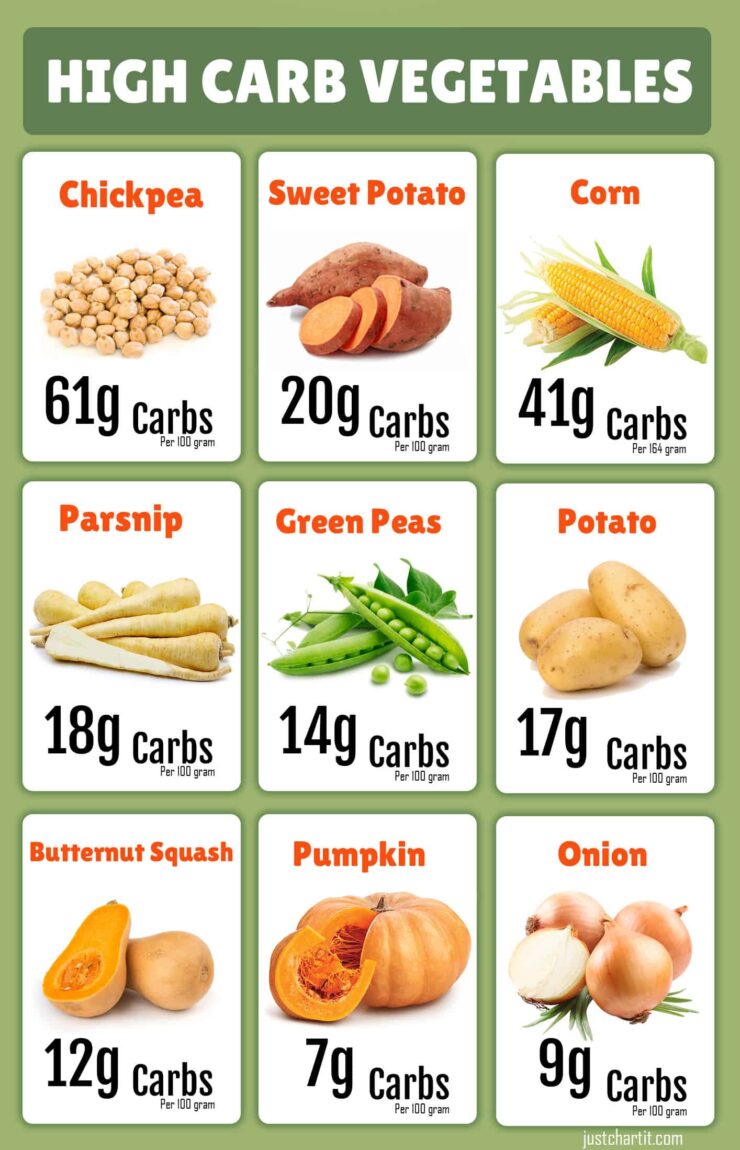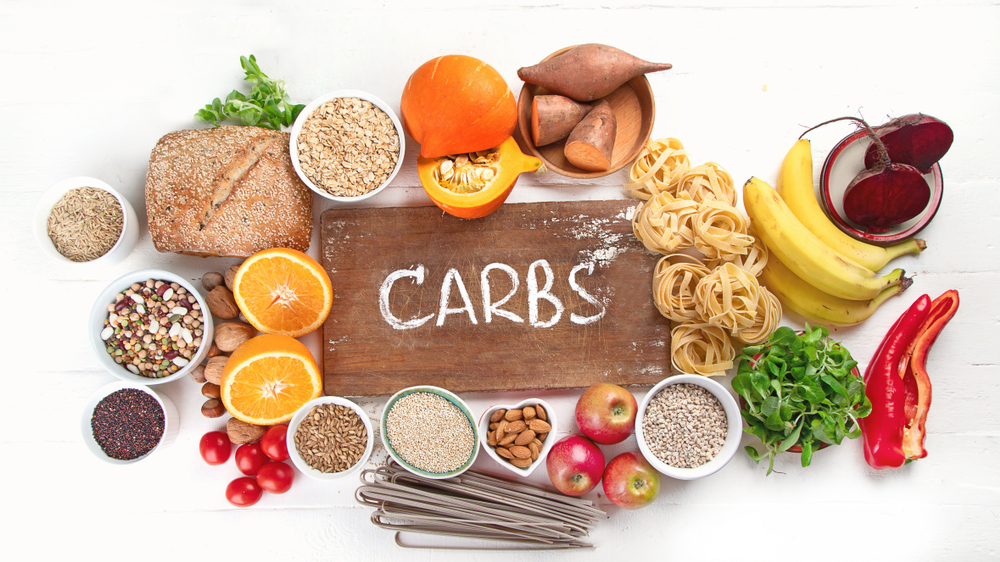Understanding Carbohydrates: The Role of Vegetables
Carbohydrates are a vital macronutrient, serving as the body’s primary energy source. Often, grains and processed foods are the first choices that come to mind when considering carbohydrate-rich foods. However, incorporating a variety of vegetables that contain carbs can offer a well-rounded and nutritious option for any diet. Vegetables are naturally low in calories, high in fiber, and packed with essential vitamins and minerals, making them an excellent choice for those looking to maintain a balanced and healthy lifestyle.
The Intersection of Vegetables and Carbohydrates: A Closer Look
Carbohydrates in vegetables typically come in two forms: simple and complex. Simple carbohydrates, such as those found in sweet corn and peas, consist of easily digestible sugars. Complex carbohydrates, on the other hand, are found in starchy vegetables like potatoes and contain longer chains of sugars that take more time to break down. This difference in carbohydrate structure impacts energy levels and overall health.
Consuming vegetables as a source of carbohydrates offers several advantages. Vegetables are naturally low in calories, making them an ideal choice for those looking to manage their weight or maintain a healthy lifestyle. Additionally, vegetables are high in fiber, which aids in digestion, helps regulate blood sugar levels, and promotes feelings of fullness. Furthermore, vegetables are packed with essential vitamins and minerals, contributing to a well-rounded and nutrient-dense diet.
Top Vegetables Rich in Carbohydrates: A Comprehensive List
When it comes to vegetables that are carbs, there is a diverse selection to choose from. Here are some noteworthy options:
Potatoes
A medium-sized potato contains approximately 37 grams of carbohydrates, making it a significant source of this macronutrient. Potatoes are also high in fiber, vitamin C, vitamin B6, and potassium. Choose from various types, such as white, red, or sweet potatoes, to add variety to your meals.
Corn
One medium ear of corn contains around 28 grams of carbohydrates. Corn is not only delicious but also rich in fiber, vitamin C, and several B vitamins. Fresh, frozen, or canned corn can be incorporated into various dishes, from salads to soups and casseroles.
Peas
A cup of cooked green peas provides about 25 grams of carbohydrates. Peas are an excellent source of fiber, protein, vitamin C, vitamin K, and several B vitamins. Add them to pasta dishes, stir-fries, or enjoy them as a side dish.
Beets
One medium beet contains approximately 13 grams of carbohydrates. Beets are rich in fiber, vitamin C, potassium, and folate. They can be roasted, steamed, or pickled and added to salads, sandwiches, or smoothies.
How to Incorporate Carbohydrate-Rich Vegetables into Your Diet
Incorporating vegetables that are carbs into your daily meals can be both enjoyable and nutritious. Here are some practical tips and advice to help you make the most of these versatile ingredients:
Get Creative with Recipes
Explore a variety of recipes that feature carbohydrate-rich vegetables as the main ingredient. For instance, try a roasted sweet potato and black bean taco recipe, or a hearty pea and mint soup. These dishes not only provide a healthy dose of carbohydrates but also offer a creative twist on traditional meals.
Experiment with Cooking Methods
Different cooking methods can significantly impact the taste and nutritional value of carbohydrate-rich vegetables. Roasting, steaming, and sautéing are all excellent options for preserving nutrients and enhancing flavor. For example, roasting beets brings out their natural sweetness, while steaming corn helps retain its vitamin C content.
Pair with Proteins and Healthy Fats
Combining carbohydrate-rich vegetables with proteins and healthy fats can create a balanced and satisfying meal. For instance, add grilled chicken or tofu to a salad with roasted potatoes and avocado, or drizzle tahini on steamed peas as a side dish.
Consider Meal Prep
Meal prepping is an effective way to ensure you consistently incorporate vegetables that are carbs into your diet. Prepare large batches of roasted vegetables, quinoa and vegetable salads, or hearty vegetable soups at the beginning of the week. This strategy not only saves time but also helps maintain portion control and reduce food waste.
Comparing Carbohydrate Counts: Vegetables vs. Grains
When considering vegetables that are carbs, it’s essential to compare their carbohydrate content to that of grains. While grains have long been a staple in many diets, vegetables can offer a healthier and lower-calorie alternative for carbohydrate intake.
Carbohydrate Content
A single cup of cooked white rice contains approximately 45 grams of carbohydrates, while a medium-sized baked potato provides around 37 grams. By choosing vegetables as a primary carbohydrate source, you can reduce your overall calorie intake while still obtaining the necessary energy and nutrients.
Nutrient Density
Vegetables that are carbs often contain higher levels of essential vitamins and minerals than grains. For example, a cup of cooked spinach offers more than 10 times the amount of vitamin K found in a cup of cooked white rice. Additionally, vegetables are typically richer in dietary fiber, which aids in digestion and helps regulate blood sugar levels.
Phytochemicals and Antioxidants
Vegetables are also a valuable source of phytochemicals and antioxidants, which have been linked to numerous health benefits, including reduced inflammation and improved immune function. Grains, on the other hand, contain fewer of these beneficial compounds.
Adopting a Vegetable-Focused Approach
By incorporating a variety of vegetables that are carbs into your diet, you can reap the benefits of lower calorie intake, higher nutrient density, and an increased consumption of phytochemicals and antioxidants. Consider swapping out grains for vegetables in some meals, such as using spaghetti squash instead of pasta or enjoying a stuffed bell pepper instead of a bread roll.
The Environmental Impact of Carbohydrate-Rich Vegetables
In addition to their nutritional benefits, vegetables that are carbs also offer environmental advantages. By choosing vegetables as a primary carbohydrate source, you can contribute to a more sustainable food system and reduce the environmental impact of your diet.
Lower Carbon Footprint
Compared to grains and other starchy foods, vegetables generally have a lower carbon footprint due to their shorter growth cycles and reduced water and energy requirements. This makes them an environmentally friendly alternative to traditional carbohydrate sources.
Reduced Resource Use
Vegetables require fewer resources, such as land, water, and fertilizers, than grains. By focusing on vegetables as a primary carbohydrate source, you can help conserve these valuable resources and contribute to a more sustainable food system.
Seasonal and Local Consumption
Emphasizing seasonal and local vegetables in your diet can further reduce the environmental impact of your carbohydrate intake. By consuming locally grown produce, you can lower transportation emissions and support regional agriculture.
Minimizing Food Waste
Vegetables offer an opportunity to minimize food waste, as many varieties can be consumed in their entirety, from leaves to roots. By utilizing all parts of the vegetable, you can reduce waste and maximize the nutritional value of your meals.
Encouraging Regenerative Agriculture
The production of vegetables can promote regenerative agriculture practices, such as crop rotation and organic farming methods. These techniques help maintain soil health, sequester carbon, and preserve biodiversity, making vegetables an environmentally responsible choice for carbohydrate intake.
Potential Drawbacks and Solutions: Balancing Carbohydrate Intake
While vegetables that are carbs offer numerous health benefits, it’s essential to consume them as part of a balanced diet. Overconsumption of any macronutrient, including carbohydrates, can lead to imbalances and potential health issues.
Avoid Overconsumption
Monitor portion sizes and ensure that carbohydrate-rich vegetables are consumed in moderation. Aim to include a variety of vegetables, proteins, and healthy fats in each meal to maintain a balanced nutrient intake.
Manage Digestive Issues
Some individuals may experience digestive issues when consuming large amounts of carbohydrate-rich vegetables, particularly those high in fiber. Gradually increase fiber intake and ensure adequate hydration to support digestion and prevent discomfort.
Consider Individual Nutritional Needs
Individuals with specific dietary requirements, such as those following a low-carb or ketogenic diet, may need to limit their consumption of carbohydrate-rich vegetables. Consult a healthcare professional or registered dietitian to determine the appropriate balance of macronutrients for your unique needs.
Pair with Protein and Healthy Fats
Combining carbohydrate-rich vegetables with protein and healthy fats can help slow down the absorption of carbohydrates, reducing the risk of blood sugar spikes and promoting satiety. Incorporate sources of lean protein, such as chicken, fish, or tofu, along with healthy fats like avocado, olive oil, or nuts and seeds in your meals.
Embracing the Versatility of Carbohydrate-Rich Vegetables: A Call to Action
By now, you understand the importance of incorporating vegetables that are carbs into your diet. These nutrient-dense powerhouses offer a wealth of benefits, from promoting overall health to supporting a sustainable food system. It’s time to put this knowledge into action and embrace the versatility of carbohydrate-rich vegetables.
Explore New Recipes
Dive into the world of vegetable-forward cuisine and discover new recipes that celebrate carbohydrate-rich vegetables. From roasted root vegetable bowls to hearty vegetable stews, there’s no shortage of creative and delicious ways to enjoy these nutritious ingredients.
Experiment with Cooking Methods
Expand your culinary skills by experimenting with various cooking methods, such as roasting, steaming, sautéing, or even spiralizing. Each technique highlights different aspects of the vegetable’s flavor and texture, providing endless opportunities for culinary exploration.
Mix and Match
Create vibrant, nutrient-dense salads by combining various carbohydrate-rich vegetables with leafy greens, proteins, and healthy fats. Experiment with flavor profiles and textures to find the perfect balance for your taste buds.
Make a Conscious Food Choice
By choosing vegetables as a primary carbohydrate source, you’re not only supporting your health but also contributing to a more sustainable food system. Embrace the environmental benefits of consuming vegetables and make a conscious choice to prioritize these nutritious and eco-friendly ingredients in your diet.








